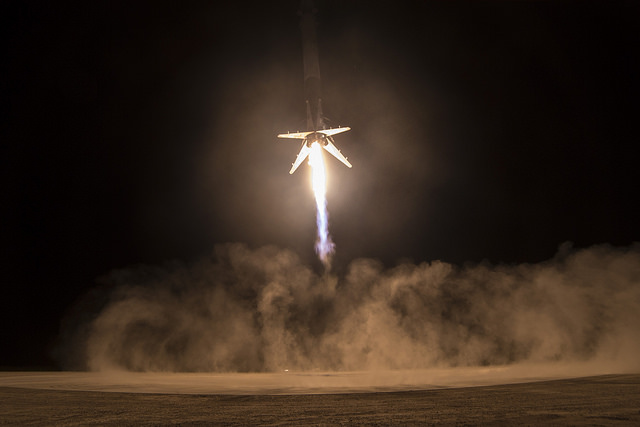
Yet more jaw dropping news from the open frontier of private space exploration.
- SpaceX describes their efforts to put a colony on Mars.
- Their fifth successful recovery of the first stage booster, a Falcon 9, tells me they are making progress on their overarching plan. Oh, and making the effort pay for itself along the way.
6/10 – Washington Post – Elon Musk provides new details on his “mind blowing” mission to Mars – Interview reveals a few more details on SpaceX’s plan for travel to Mars and building a colony there.
This is no longer in the pure fantasy realm. Things have moved so fast that it’s actually a possibility.
First unmanned spacecraft will go to Mars in 2018. Flights will continue approximately every two years thereafter, scheduled to provide the minimum flight time to Mars.
Concept is there would be a regular schedule of launches which scientists could plan on. The analogy is a regular cargo route.
Next flight in 2020 would include two Dragon spacecraft. The plan for a 2022 launch will take stuff to start a colony.
First manned flight would be in late 2024 with landing on Mars to follow in 2025.
The goal is not to get just a few people on Mars, but instead to have an infrastructure robust enough to create a self-sustaining city.
Mr. Musk acknowledges it will be dangerous and there is a good chance of losing some people. He thinks SpaceX will be able to find people willing to take that risk.
I’m confident there will be a long line of qualified, capable people anxious to volunteer even knowing they might die in the process.
Behind the Black says on 6/10:
The key to Musk’s effort is that he plans on doing it. He isn’t sitting around waiting for others, or trying to convince others to join him in a partnership before proceeding. He is simply doing it, and is welcoming others to take advantage of the opportunity he is offering.
One commenter speculated Mr. Musk is focused on Mars for two reasons. First, the novelty (as for the moon, remember the old phrase been there, done that). Second, successful flights there would put SpaceX in a position of being the premier cargo hauler in the solar system. In turn that positions SpaceX to be the go-to provider for moving cargo into space, to the moon, or to asteroids. Commenter thinks that will be extremely profitable work. As with economics, this commenter speculates a mission to Mars will not cost dramatically more than a mission to the moon.
If that commenter’s observation are correct, becoming the premier provider of launch services will not cost much more than a moonshot and can only be undertaken every 24 months because of the location of the planets. Sounds like a brilliant move to me.
A different commenter draws the analogy to Elon Musk being this generation’s Howard Hughes.
6/17 – Behind the Black – Exploring Space in the 21st Century – Robert Zimmerman is working on a major policy paper on the different approaches the federal government is taking to space exploration. The traditional huge project approach and new private commercial efforts are compared. His observation:
Commercial space ($4 billion) cost one tenth that of Orion/SLS ($43 billion), took one third the time to go from concept to launch (5 years versus 15 years), and accomplished ten times more (22 rockets/capsules versus 2.5 rockets/capsules).
The policy paper will be called:
Exploring Space in the 21st Century: How the American space effort since 2000, both private and public, is changing the global aerospace industry,
I’ll be watching for the paper. Will have lots to say about it when it appears.
7/18 – Space.com – No. 5! SpaceX Lands Another Rocket During Space Station Cargo Launch – The ninth resupply mission run sending a Dragon capsule to ISS also resulted in the fifth successful recovery of a Falcon 9 first stage.
Here is a tape of the live SpaceX feed during the launch.
(link: youtu.be/ThIdCuSsJh8)
At about the T+2 minute point, a cool view shows the plume from each of the nine engines. At about the 25 minute point you can see the successful recovery of the first stage recovery on land. Much better view since the camera is further away, stable, with lights at the landing zone.
In an entertaining problem, SpaceX is close to piling up more recovered first stages than it has storage space. They will have the delightful challenge of having to get some more hangars. Extremely cool.
7/17 – SpaceX Aims to Re-Launch Landed Rocket This Fall – Plan is to re-use a first stage Dragon 9 sometime this fall. Company is in negotiations for a customer. Behind the Black guesses the shot will carry two SES satellites. SES has apparently indicated they are willing to go with a used booster.